Learn how to make fermented buckwheat bread that uses no starter and is also gluten-free and sugar-free.
One of the greatest things I discovered after adopting plant-based diet was raw buckwheat – you can make boiled porridge, raw buckwheat porridge or ricotta, ricotta creams for cakes or to eat as is; to make cookies and pancakes, use soaked groats for buckwheat muffins and cakes, just boil for side or make patties, and even make yeast-free fermented buckwheat bread.
How to Make Fermented Buckwheat Bread
What is Buckwheat?
Buckwheat spread to Europe and Russia in the 14th and the 15th century from China, and the Dutch brought it to USA in the 17th century. Many of you might not know that buckwheat is actually not a grain, but a fruit seed related to rhubarb and sorrel and therefore is gluten-free and safe for those with celiac disease.
Buckwheat consists mainly of carbohydrates, but like seeds, it is also high in protein. Buckwheat is a very good source of manganese and a good source of magnesium, dietary fibre, copper, and phosphorus. Furthermore, it contains health-promoting flavonoids rutin and querceitin. Rutin functions with vitamin C to maintain healthy capillaries, to help heal wounds, to help form collagen in connective tissue, and to support a healthy immune system. Quercetin has antioxidant and anti-inflammatory effects.
Buckwheat groats have low glycemic index, meaning that unlike wheat flour, its carbohydrates break down slower, which make them more filling for a longer period of time, with less of an undesirable impact on blood glucose and insulin. Buckwheat groat protein also has a better structure than wheat protein, which has a poor amount of the amino acid lysine, with twice the amount of fibre compared to wheat.
The Ingredients
This fermented buckwheat bread consists of very simple wholesome ingredients.
The main component is raw buckwheat groats i.e., not roasted buckwheat.
Then, for flavour, we’re using Himalayan salt and oregano.
Finally, let’s add some sunflower seeds. However, you can use any seeds of preference or, for a leaner version, discard them altogether.
The Process
Start by soaking raw buckwheat groats overnight or at least for 2 hours. It’s very important to rinse the soaked groats well (they get slimy after soaking) and then let drain for at least 5 minutes to get the extra water out. If you don’t follow this step with scrutiny, your batter may end up too runny and the bread won’t rise.
Next, place the drained buckwheat groats into blender with 290 ml of water. Blend on low speed until smooth batter forms.
Then, pour the batter into plastic or glass bowl (do not use metal bowl). Cover the bowl with clean cloth and place into a warm oven (35°C, 95°F).
Now it’s down to letting the batter ferment for 7 hours. After 7 hours you’ll see that the batter has risen and small bubbles have formed. If you don’t see that, let it ferment a bit longer.
Then, add all the other ingredients to this buckwheat bread recipe and gently and briefly stir with wooden or plastic spoon (do not use metal spoon). Do not over-mix as the batter will lose its fluffiness.
Pour the batter into a loaf pan lined with parchment paper. By the way, you can put the bread back into warm (not hot!) oven and let it rise for another few hours or you can bake it immediately for 1 hour at 175°C (350°F).
NB! Let the bread be in the oven while it warms up and DO NOT use speed heating or fan! Count the hour from when the oven has reached the right temperature. I put the timer to 1 hour and 10 minutes as it takes 10 minutes to reach 175°C (350°F).
If you used parchment paper, you can remove the bread from pan immediately and place it on folded kitchen paper (I use four layers) to absorb the moistness. Let the bread cool for at least 30 minutes before slicing (the longer the better).
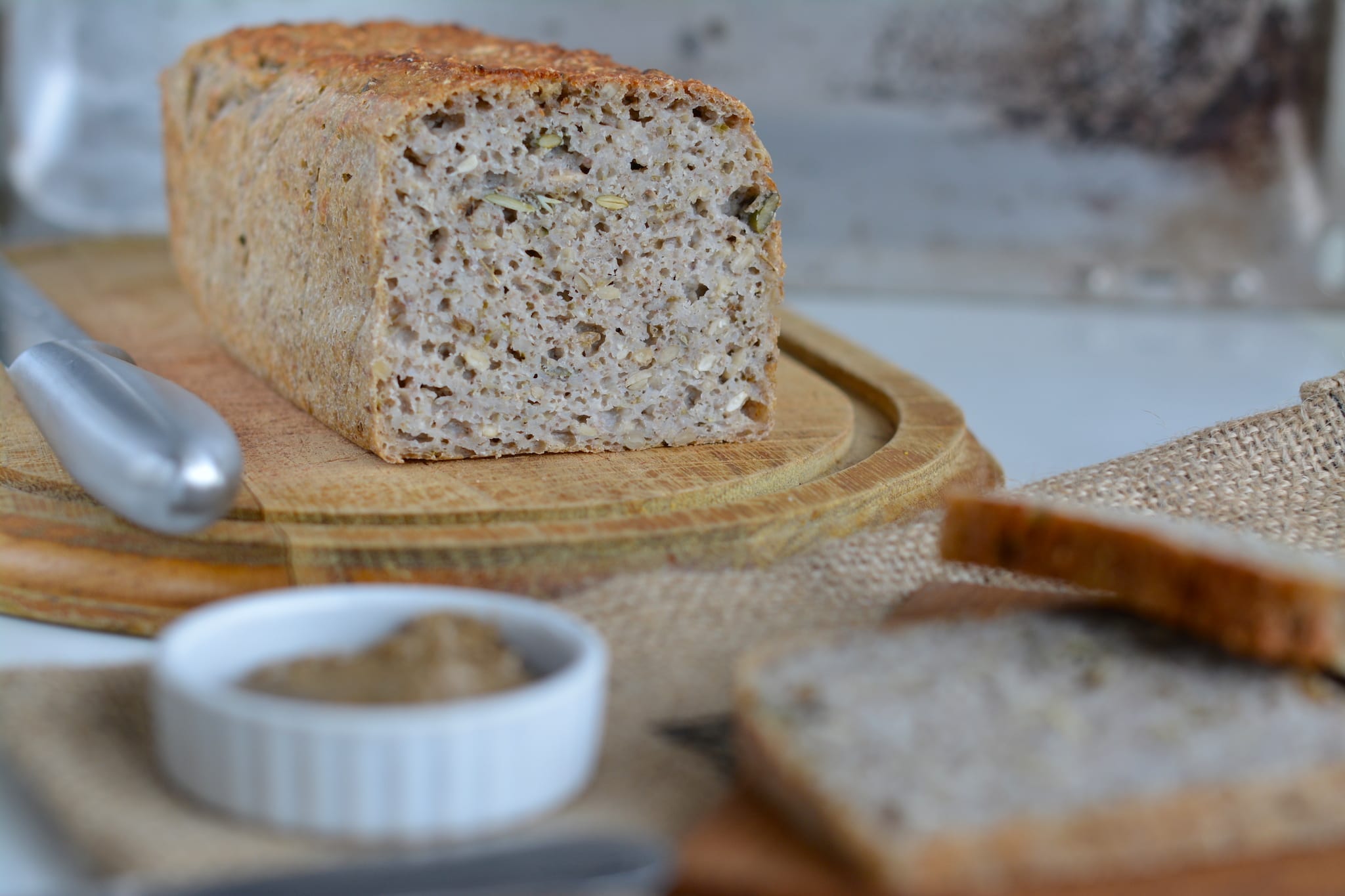
How to Serve
In my experience, freshly baked sourdough bread is so damn good that you don’t even need anything to accompany it with. However, should you disagree, here are some ideas:
Spread the bread with homemade hummus, avocado, nut or seed butter (tahini, almond butter, peanut butter, cashew butter), homemade applesauce, hummus, homemade vegan mayonnaise, or even sweet buckwheat ricotta.
In addition, top it with red cabbage coleslaw, sauerkraut, kimchi, tofu or tempeh slices, or vegan egg salad.
You can use a few or many of the options mentioned above and build an epic healthy vegan sandwich. On the photo below I used avocado spread, fermented tofu, kimchi and broccoli sprouts for delicious toasts.
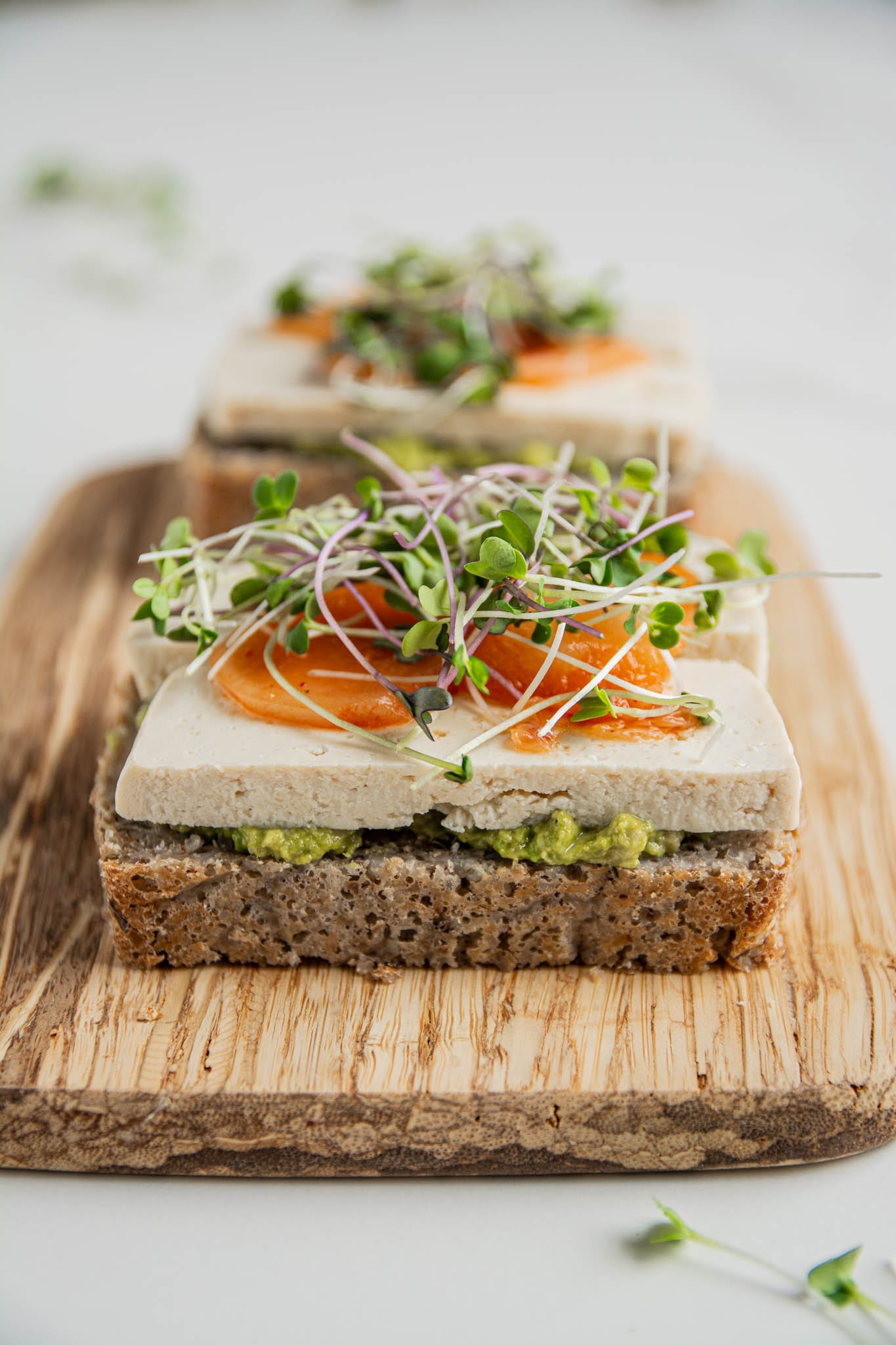
How to Store
When the bread is cooled, wrap it into a clean kitchen towel and stick it into a plastic bag to prevent losing too much moisture. It keeps well on countertop for 2 days.
For longer keeping, slice the bread up as soon as it’s cooled and store the individual slices in freezer. Heat them up in a microwave (for soft result) or in oven or toaster (for crunchy slices).
In order to toast the frozen sourdough bread slices in the oven, place them onto the rack (not on a baking sheet), set the oven to fast heat function (175°C, 350°F is enough) and timer to 10 minutes. When the time’s up, you’ll have fresh and crispy bread ready to enjoy.
I have made fermented buckwheat bread for two years now. I was a bit tired of rye bread and thought that it should be possible to ferment buckwheat as well. So, I started to search online (not to invent a wheel) and found a recipe by Concious Catering. After playing with the quantities and ingredients I developed my own favourite fermented buckwheat bread recipe.
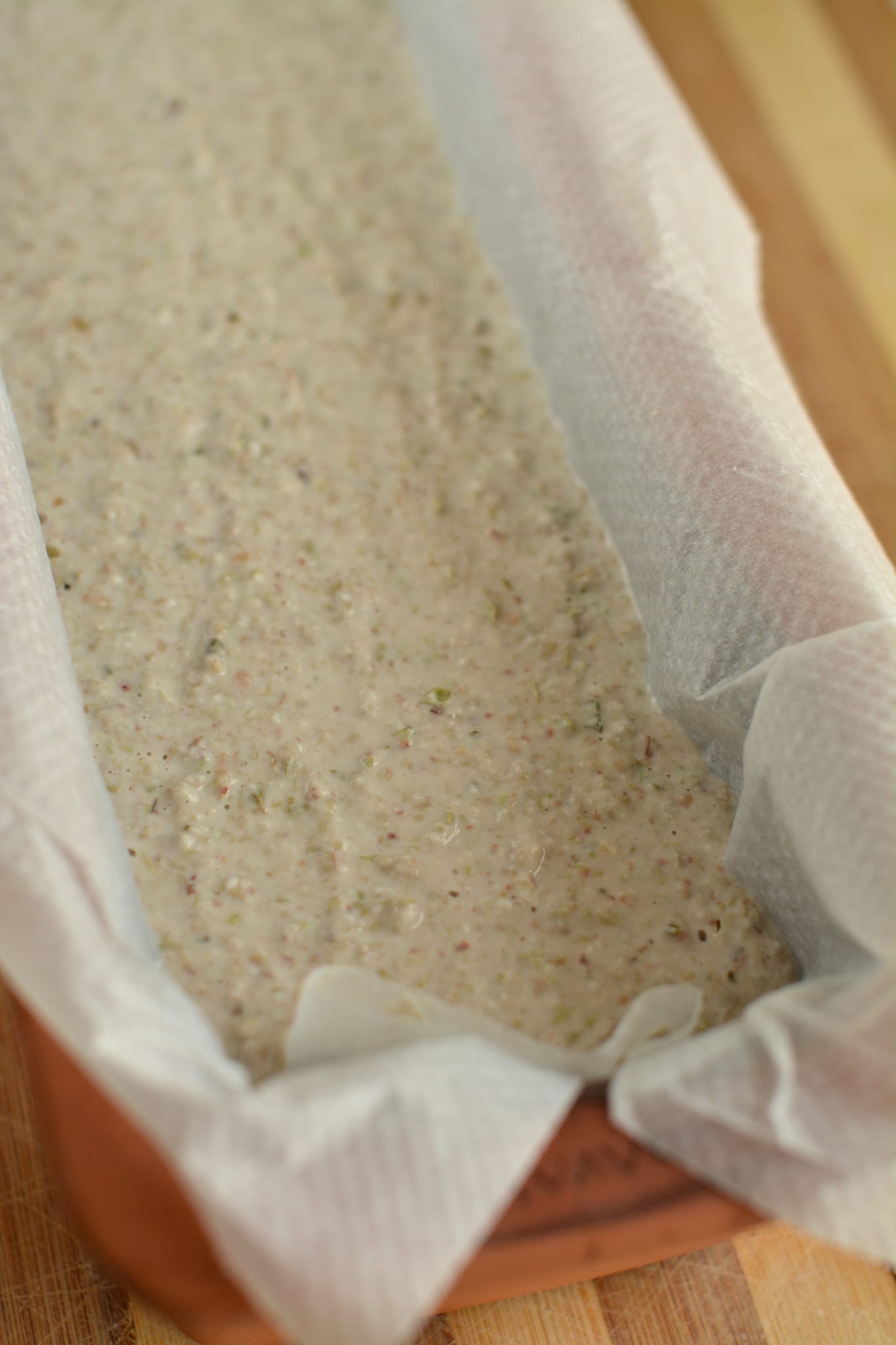
Make sure to watch the below video for visuals!
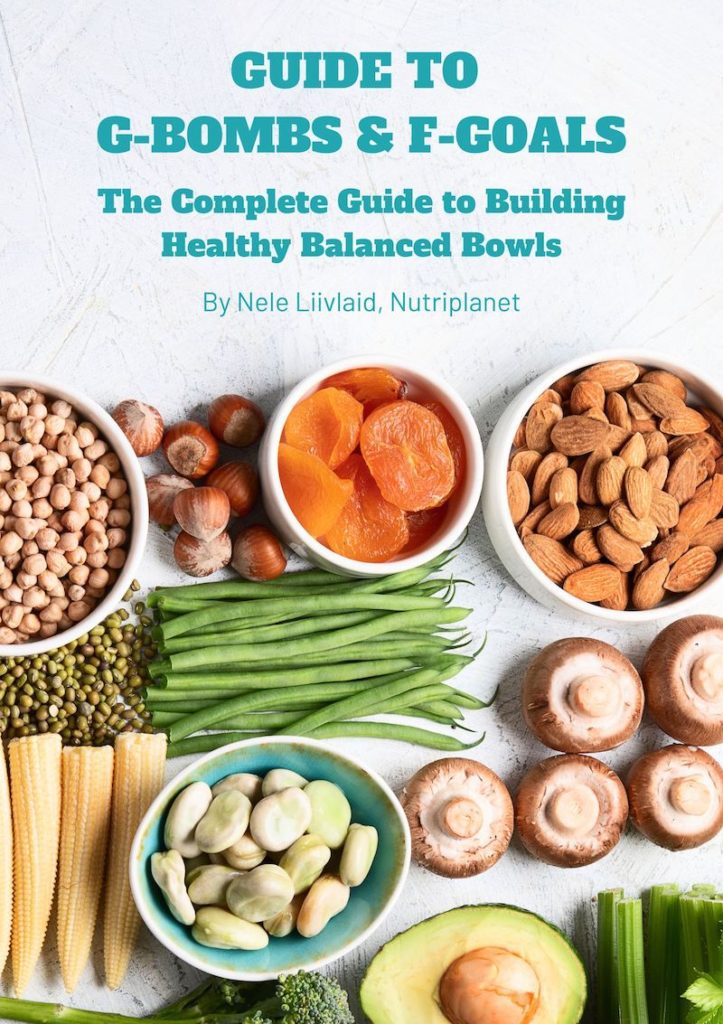
Step-by-step visual guide to building your own balanced bowls.
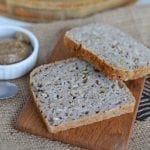
Fermented Buckwheat Bread Recipe
- Total Time: 1 hour 10 minutes
- Yield: 22 slices 1x
- Diet: Vegan
Description
Learn how to make fermented buckwheat bread that uses no starter and is also gluten-free and sugar-free.
Ingredients
- 425g (15oz) raw buckwheat groats
- 290ml or grams of water (10.2oz) + water for soaking buckwheat
- ½ tsp. Himalayan salt
- 2 tbsps. oregano
- 3 tbsps. of sunflower seeds
Instructions
- Soak buckwheat groats for at least 6 hours. It’s very important to rinse the soaked groats well (they get slimy after soaking) and let drain for at least 5 minutes to get the extra water out. If you don’t follow this step with scrutiny, your batter may end up too runny and the bread won’t rise.
- Place drained buckwheat groats into blender with 290ml of water. Blend on low speed until smooth batter forms.
- Pour the batter into plastic or glass bowl (do not use metal bowl). Cover the bowl with clean cloth and place into a warm oven (35°C, 95°F).
- Let the batter ferment for 7 hours. After 7 hours you’ll see that the batter has risen and small bubbles have formed. If you don’t see that, let it ferment a bit longer. Now add all the other ingredients to this buckwheat bread recipe, gently and briefly stir with wooden or plastic spoon (do not use metal spoon). Do not over-mix as the batter will lose its fluffiness.
- Pour the batter into a loaf pan lined with parchment paper. Now, you can put the bread back into warm (not hot!) oven and let it rise for another few hours or you can bake it immediately for 1 hour at 175°C (350°F). Let the bread be in the oven while it warms up. Count the hour from when the oven has reached the right temperature.
- If you used parchment paper, you can remove the bread from pan immediately and place it on folded kitchen paper (I use four layers) to absorb the moistness. Let the bread cool for at least 30 minutes before slicing (the longer the better).
Notes
One slice has 7.3 GL points.
- Prep Time: 10 minutes
- Cook Time: 1 hour
- Method: Baking
Nutrition
- Serving Size: 45g (1.6oz) slice (1/22 of recipe)
- Calories: 69.3 kcal
- Sodium: 26mg
- Fat: 1.07g
- Carbohydrates: 11.7g
- Fiber: 1.24g
- Protein: 2.58g
Zinc is an essential mineral that supports the immune system, digestive system, cellular growth and development, and more. This certified organic, liquid formula contains zinc derived from guava leaves, enhanced with Energized Trace Minerals for increased bioavailability.
Other combinations for flavouring:
- Olives and oregano
- Sundried tomatoes and oregano
- Sesame seeds and oregano
- Walnuts, prunes, cinnamon
- Sunflower seeds, pumpkin seeds, oregano
- Raisins, cinnamon
- Poppy seeds, goji berries
Tips on this fermented buckwheat bread:
- If you can’t set your oven to such low temperatures, ferment the bread batter at room temperature. I’d still recommend putting the bowl into oven for the most stable environment (less temperature changes or breeze). It’ll take about 16-24 hours.
- It is at its best when fresh.
- Slice the leftover bread and store in freezer. Heat up in the oven or toast slices whenever needed.
- Eat as it is or with hummus, guacamole or nut/seed spread for example.
- Should you like more sour taste, ferment the batter for longer.
Disclosure: this post contains affiliate links. As an Amazon Associate and Global Healing affiliate I earn from qualifying purchases. For every purchase made from the links in this post, you’ll be able to support my work. So you can look after your health, and contribute to my mission at the same time. Thank you!
Feel free to PIN the below image!
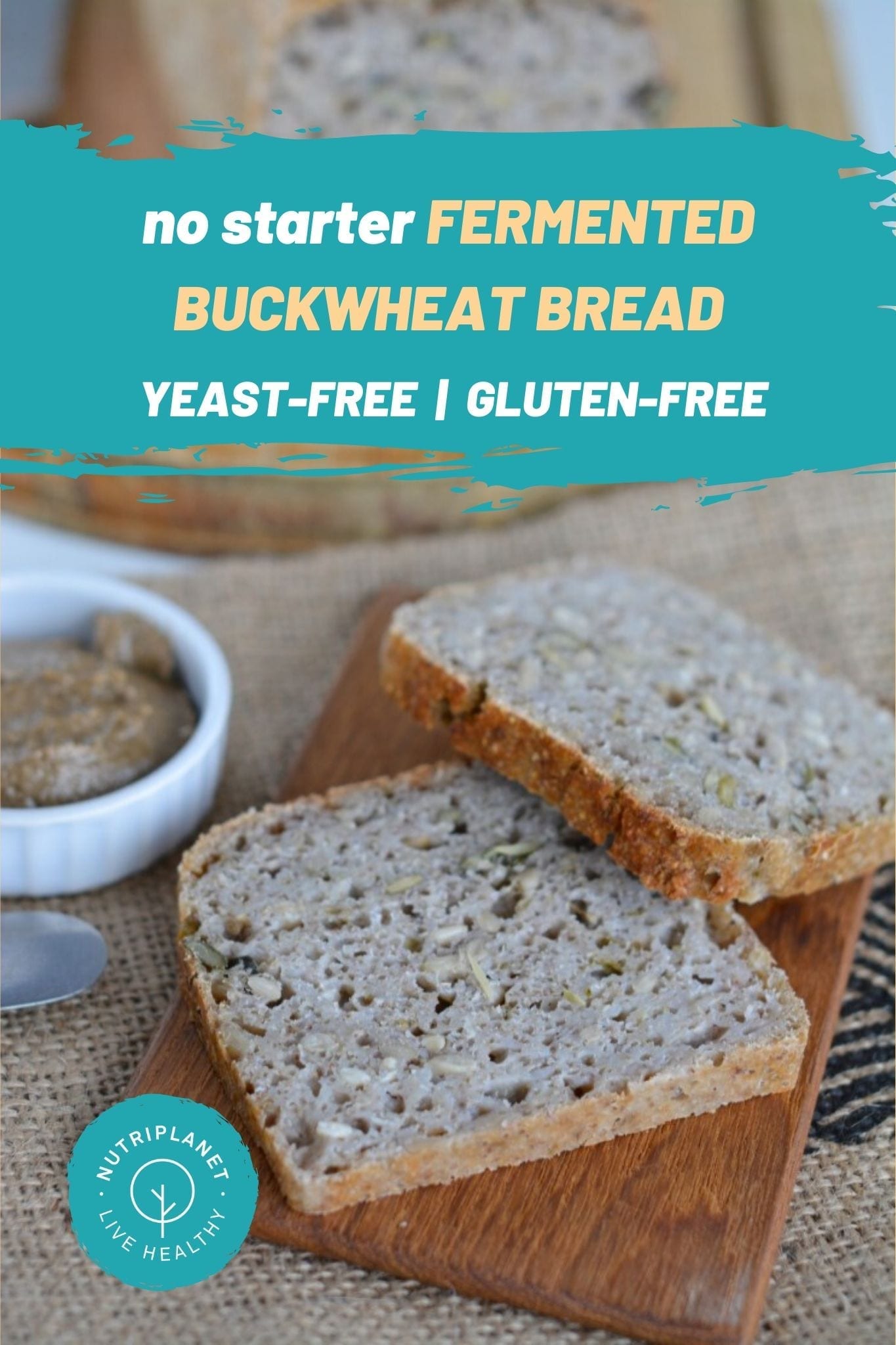
This post is also available in: Spanish

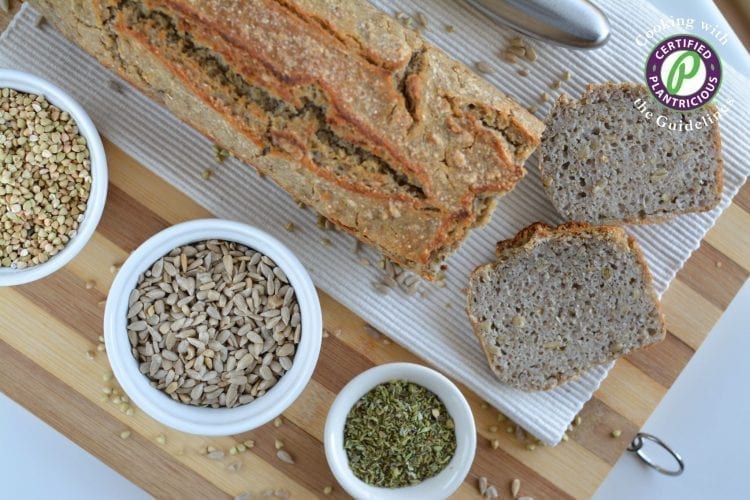
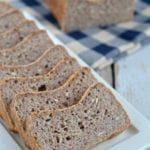
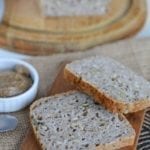
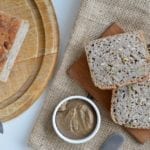









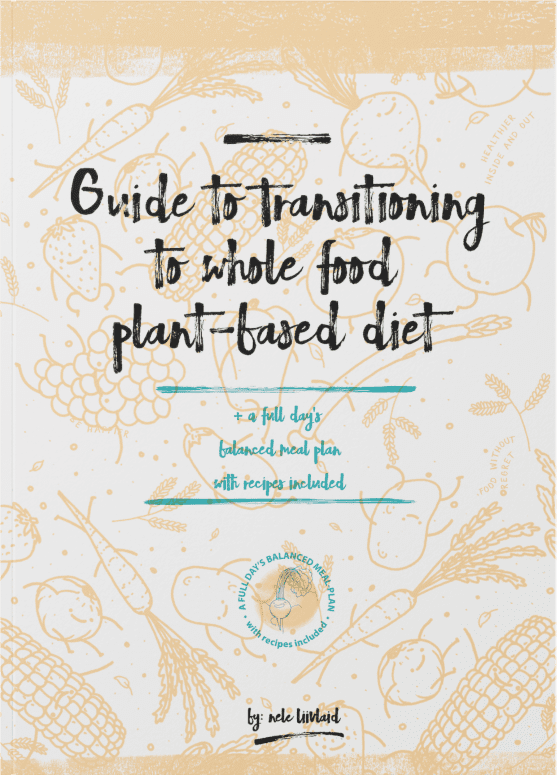
Hi there and thanks for the recipe. Can you please tell us what size loaf pan we should use? Thanks!
Hi!
My handmade ceramic loaf (27x9cm) is not standard. I’d say go for 25x9cm.
I made this bread today and the results were good with some changes to the original recipe. I soaked my buckwheat groats overnight and when I was ready to grind them in the blender, I made sure to give them a good wash and drain first. Buckwheat groats when soaked develop a slimy coat. I made sure to mix them well in the strainer under running water to remove this and then let them drain for ten minutes giving them the occasional shake. I then added them to the blender (Vitamix) and added 250 ml / 1 cup of water. I then blended until smooth. This batter was thick enough to hang onto developing fermentation bubbles. I think if I had added the 300 ml of water that the recipe called for the batter would be too thin. I went ahead and added the salt to the batter while it was in the blender but I only used half of the suggested amount as I am salt sensitive. The batter was then transferred to a glass bowl with a plastic lid and allowed to sit out over night in my kitchen. I did not see any fermentation sign in the morning and left it to it’s own devices until the afternoon. At that point I placed it in my oven and in about four hours when checked on the batter had developed. I decided that I didn’t want to add any seeds or herbs to the bread as I didn’t want to disturb the rise. I gently transferred the batter to a lined tin with as little disturbance as possible and placed the batter back in the oven for an hour to recover. I then fired up the oven at 350 deg. with the bread in the oven, no preheating. I started counting the bake time after seven minutes. The bread took two hours to bake. When a toothpick is inserted it will still come out somewhat gummy. This is a bread that has a good crust and a very moist interior. It does not have the same texture as a wheat bread, but it’s nice. The groats that I used are fresh, meaning that they haven’t been stored for a long time. I used tap water to soak them and I used tap water to make the batter. The pan size was 8″ x 4″ and metal, lined with parchment. I hope that I have shared enough information here to help others have a successful baking experience.
Hi Signey,
Thank you for your insight! I’m glad you like the bread!
Indeed, I instruct to rinse and drain the soaked buckwheat well — yes, it does get slimy!
This bread is also delicious with no salt added — lately I’ve been making it totally salt-free.
And yes, you got it right that the bread needs to be in the oven while it warms up — this is what I suggest in the recipe as well. However, it takes 1 hour (+ 10 minutes when it heats up to 350) to bake it in my oven — I guess ovens are different.
Again, thanks for sharing your experience!
Hi Nele, You gave a great step by step description of the steps you took to make your bread. I repeated the importance of some of those steps because they could make a difference with the wetness problems people have been having. I think the point of rinsing the groats well bears repeating as I tried making a soaked buckwheat bread from another site and didn’t realize the “slime factor”. I was very surprised to find that after I had washed it, it still had a bunch of slime in the interior of the mass of groats. Insufficient washing and draining of the soaked groats could lead to the batter being too thin to hold the fermentation bubbles well. As for ovens, I do have an older oven and this could be why it took longer to bake. I suspect though that it has more to do with how long the groats soak, their water uptake, and how much water is added to the groats for blending. I appreciate this recipe and I intend to experiment more with it. Thank you!
Thanks again! I’ll emphasise those steps in my instructions!
Hi Nele! I’m making this right now! Quick question – when you say “blend until a smooth batter” I was wondering how smooth. I’ve been blending my groats for a while now and the substance is smooth-ish but granular. Is this sufficient or should it be 100% smooth? My blender is just a regular blender not a Vitamix and I can’t see the batter getting any smoother than it is now! Thanks!
Hi!
Not silky-smooth, no! However, all the groats should be well blended, i.e. there should not be intact groats. You can also check the video for the batter consistency! I don’t have a Vitamix either 🙂 Lately I’ve been processing the buckwheat with immersion blender — I find they blend easier than with regular blender.
Thank you, Nele! Is the video on this page? I see a photo with a little play icon on it, but it isn’t clickable.
I’ve let my batter sit at room temp for about 24 hours but I’m not seeing bubbles yet. I’m concerned if I leave it out any longer it will spoil. But it sounds like baking it without bubbles also won’t yield anything?
Hi!
You were right — for some reason it didn’t play! Thanks for letting me know! I’ve moved the video to the top of the post and it’s clickable now!
What is your room temperature? If it’s very low (20C or lower) it can take longer than 24 hours.